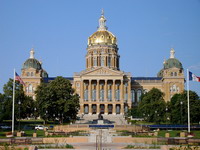Login form
Iowa

Iowa is sometimes called the Corn State. It produces more corn than any other state. Popcorn comes from corn kernels. Corn on the cob is delicious to eat. Corn is used in making many breakfast cereals, too. It also goes into such varied products as mayonnaise, crayons, and plastics.
Much of Iowa’s corn is used to feed cattle and hogs. Iowa raises more hogs than any other state. Soybeans, hay, and oats are other important crops in Iowa. Farmland covers about 90 percent of the state. Agriculture has always played a big role in Iowa life. Iowa also manufactures farm machinery, computers, and other products.
|
Facts About Iowa |
|
|
|
|
|
Capital |
Des Moines |
|
Population |
2,940,000 people |
|
Rank among states in population |
30th |
|
Major cities |
Des Moines, Cedar Rapids, Davenport, Sioux City |
|
Area |
56,300 square miles |
|
Rank among states in area |
26th |
|
Statehood |
December 28, 1846, the 29th state |
|
State nickname |
The Hawkeye State |
|
Name for residents |
Iowans |
|
State bird |
American Goldfinch |
|
State flower |
Wild Rose |
|
State tree |
Oak |
|
Abbreviation |
IA |
A CENTRAL STATE
Iowa is a land of flat, fertile plains. It lies in the heart of North America. Iowa’s central location in the United States has made it an important passageway from pioneer times on. Railroads and superhighways later replaced pioneer trails across the state.
Each July, about 10,000 cyclists cross Iowa on bicycles. They ride for six days from Sioux City on the Missouri River to Davenport on the Mississippi. Two writers at the Des Moines Register, an Iowa newspaper, started RAGBRAI (Register’s Annual Great Bicycle Ride Across Iowa) in 1973. Many other states later copied the idea.
THE HAWKEYE STATE
Iowa is nicknamed the Hawkeye State. The name honors Black Hawk, chief of the Sac (Sauk) Native Americans. Treaties forced the Sac and Fox to give up their land in Illinois and Wisconsin. In 1830, Black Hawk and his people moved to Iowa. In 1832, after a hard winter in Iowa, they tried to return to their old territory.
Battles known as the Black Hawk War began in 1832. An army of soldiers and settlers chased Black Hawk’s band of Sac and Fox from their old territory westward toward the Mississippi River. They reached the river on August 3, but a steamboat carrying soldiers and cannons blocked their way. They were trapped. Black Hawk tried to surrender. The cannons fired and the soldiers attacked.
Most of Black Hawk’s people died on August 3, 1832. The battle is known as the Bad Axe Massacre. It was the final battle of the Black Hawk War. After their defeat in the war, the Sac and Fox had to sell their land in Iowa to white settlers. Much later, some Sac and Fox Indians bought land in Tama County Iowa. Today, their descendants live there.
THREE RIVERS
Three rivers have played an important part in Iowa’s history. The Mississippi River forms Iowa’s eastern border with Wisconsin and Illinois. The Missouri forms the state’s western border with South Dakota and Nebraska. Iowa is the only state bordered by two rivers that are deep and wide enough for ships.
The state’s third river is the Iowa River. It is the longest river inside the state. The river and the state were named after the Iowa Indians.
Early settlers in Iowa chose to live in the river valleys. Here, they could find water, wood for building, and food.
FRENCH TERRITORY
In 1681 and 1682, French explorer René-Robert Cavelier, Sieur de La Salle led an expedition down the Mississippi River to the Gulf of Mexico. He claimed land, including Iowa, for France. He named the area Louisiana in honor of French king Louis XIV.
France sent fur traders to the region. But the French didn’t settle Iowa right away. Iowa’s first white settler was Julien Dubuque, a French Canadian. In 1788, Dubuque got permission from the Fox peoples to mine lead on Fox land near the Mississippi River. The city of Dubuque, near the lead mines, is named after him.
In 1803, the United States purchased the Louisiana Territory from France. Iowa belonged to the United States.
STATEHOOD
After the Black Hawk War, farmers began to move to Iowa because of its fertile land. Iowa became a territory in 1838. By 1840, most of its 40,000 residents lived close to the Mississippi River. On December 28, 1846, Iowa became the 29th state of the Union. Iowa City was the first capital. In 1857, the capital was moved to Des Moines, a city close to the center of the state.
THE AMANA COLONIES
An interesting place to visit in Iowa is the Amana Colonies. You can see how pioneers lived and worked in this historic community. German-speaking settlers founded Amana in 1855. The settlers sought freedom to practice their religion and their beliefs about how people should live together in a community.
The Amana colonists shared all property. The community decided what work people should do. No one received a paycheck. Instead, community members got what they needed at the general store. The community decided what each family could spend. There were community kitchens, in which all the families ate.
In 1932, the community voted to abandon their practice of sharing everything. Farming remains important in the community, but today manufacturing and tourism also provide income.
Source: Microsoft ® Encarta

